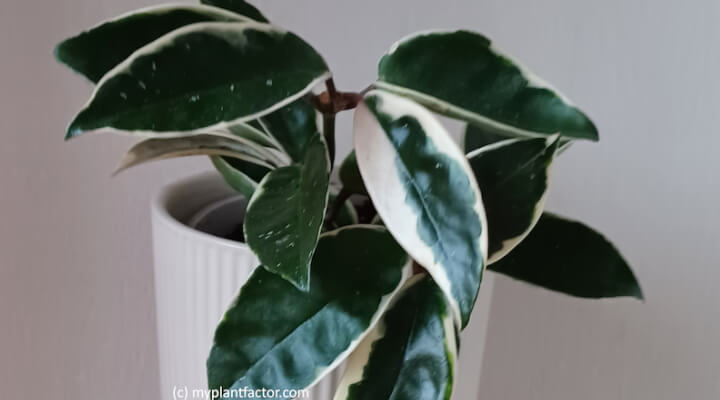
How to Identify Hoyas by Their Leaves (Even If They’ve Never Bloomed)

You may think that hoya leaf identification feels like a science. But in reality, learning as much as possible about hoyas and their foliage is a journey into the heart of what makes these plants so captivating.
Table of Contents
- What’s So Special About Hoya Plants?
- What do Hoya leaves look like? Key Traits to Look For
- Spotlight on the Most Popular Hoya Varieties
- Are Hoya Leaves Toxic to Cats?
- Top Tips on Mastering Hoya Leaf Identification
- Overcoming Common Challenges When Identifying Hoya Leaves
- Maintaining Healthy Leaves for Better Identification
- Engage with the Hoya Community
- Quick FAQ for Hoya Leaf Identification
If you’re like me, you’re probably struggling to identify hoya plants by their leaves. Once, I mistook Hoya Pubicalyx for Hoya Shepherdii, bought two splashy vines online, and ended up with the same plant under different names. Classic hoya mix-up.
Truth is, hoyas don’t always come labeled—and with over 500 species and hybrids, leaf clues are your best friend.
Their glossy textures, intricate shapes, and splashy variegation are beautiful. But there’s more. They are clues to understanding a world of over 300 species of hoyas, each with its own story. Whether it’s the heart-shaped beauty of Hoya Kerrii or the cascading elegance of Hoya Linearis, identifying Hoyas can feel like cracking a botanical code.
That’s why I made this guide. You’ll learn to recognize types of hoyas by leaf shape, texture, splash, and veins, even if they’ve never bloomed. I’ve grouped them visually so you can match what’s on your shelf to the plant in your cart.
What’s So Special About Hoya Plants?
Hoya plants are more than just greenery—they’re living art. Known as “wax plants” for their glossy, almost otherworldly leaves, Hoyas have a way of drawing you in. Whether it’s the intricate patterns on Hoya Pubicalyx or the heart-shaped charm of Hoya Kerrii, each plant has a unique personality that’s hard to ignore.
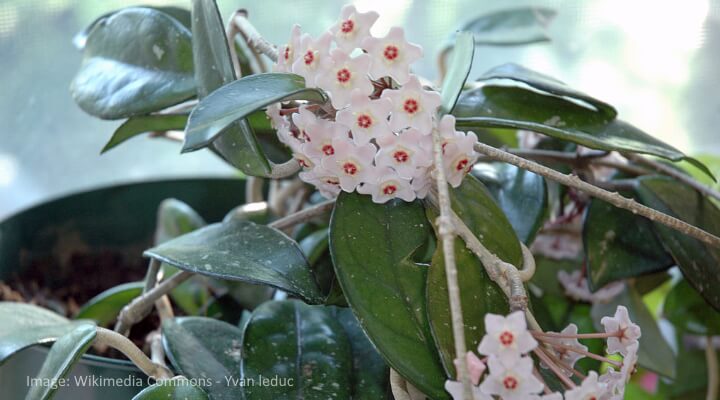
But it’s not just about looks. Hoyas are surprisingly resilient, thriving in homes with minimal care. They purify the air, trail elegantly from shelves, and some even reward your patience with clusters of fragrant, star-shaped flowers. For plant lovers, they’re the perfect mix of beauty and endurance. That’s why Hoyas are more than plants—they’re collectors’ treasures.
Quick question: Why is everyone suddenly obsessed with hoyas?
Find out which varieties are beginner-friendly, what their blooms smell like (hint: dessert!), and how to get them to thrive indoors.
🔗 Explore the best varieties hoyas for beginners now
What do Hoya leaves look like? Key Traits to Look For
I’ve found that identifying Hoya leaves is all about paying attention to the details. Each leaf tells a story—if you know how to read it. Over the years, I’ve learned to break it down into a few key traits, and here’s my go-to guide. I’m sure it will help you figure out exactly which Hoya you’re caring for.
Shape and Size
The first thing I notice is the shape and size of the leaves. Some species are obvious—like the heart-shaped Hoya Kerrii—but others, like Hoya Retusa, with its thin, spindly blades, are a little trickier. Then there are species like Hoya Macrophylla, which has oversized leaves that make it stand out immediately.

One reader shared, “I thought my plant was a Kerrii because of the heart shape, but it turned out to be a single-leaf cutting and didn’t grow for months!” This is why it’s important to check size and growth habits together.
Texture
I always run my fingers gently across the leaves. Most Hoyas feel waxy and smooth, so they’re nicknamed “wax plants.” But a few are exceptions. Hoya Fungii, for example, has velvety leaves that feel like suede, and Hoya Compacta’s tightly curled foliage is rough and rope-like.
One community member wrote, “When I touched my Compacta for the first time, I couldn’t believe it wasn’t a succulent. The texture threw me off completely!”
🔍 Worried About Hoya Leaf Damage? Check Out My Houseplant Pest Identification Guide
Color and Variegation
Color and variegation patterns are one of the easiest ways to identify a Hoya. Look closely at the leaves—are they a uniform green, or do they have silver, cream, or pink splashes? I’ve noticed that lighting plays a massive role in how variegation appears. My Hoya Carnosa Krimson Queen has much brighter variegation when it gets plenty of light, while lower light makes the cream fade back to green.
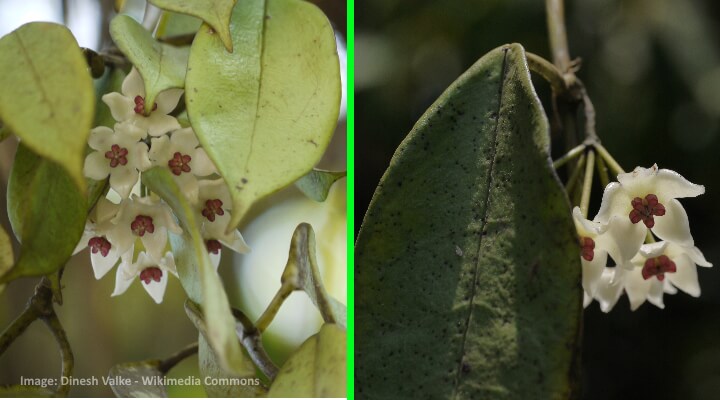
A frustrated grower once shared, “I thought I bought a Krimson Queen, but after a month in my low-light bedroom, all the variegation disappeared. I thought I’d been scammed!” It’s a good reminder to assess plants under optimal conditions.
Veining Patterns
Sometimes, the veins on a leaf can solve the puzzle. For example, Hoya Macrophylla has bold, white veins that make it unmistakable. Other species, like Hoya Carnosa, have more delicate and subtle veining. I’ve learned that photographing the veins in natural light helps when comparing with online guides or asking for advice in plant forums.
Leaf Arrangement
I’ve also noticed how leaves grow along the stem, which can be a giveaway. Like Hoya Pubicalyx, most Hoyas grow their leaves in pairs, creating a symmetrical pattern. But some species, like Hoya Retusa, have a more scattered arrangement that’s easy to spot.
Growth Habit
Lastly, I look at the overall growth of the plant. Is it a trailing vine like Hoya Linearis, or does it stay tightly clustered like Hoya Compacta? Growth habits often give you clues that leaf details alone can’t, especially for hybrids.
One forum post I read said, “I almost mislabeled my Linearis because I didn’t realize how long and elegant its vines would become. The growth habit totally confirmed what I had.”
What I’ve learned about identifying hoyas by their leaves
Lighting, care, and the environment can transform a Hoya’s appearance. When I’m identifying a new plant, I always inspect it under bright, indirect light to see the most accurate version of its color and texture. And if I’m stuck, I photograph the leaves and compare them to trusted guides or share them in plant communities for feedback.
My quick tip
Document your observations. Take photos, jot down notes, and compare your findings to this guide or community feedback. Identifying Hoyas can initially feel daunting, but it gets easier the more you practice. And trust me, there’s nothing like the moment it clicks and you can finally name your leafy companion.
Are Hoya Leaves Toxic to Cats and Dogs?
Most hoya plants are considered non-toxic to cats and dogs. According to the ASPCA, Hoya Carnosa and similar species aren’t known to cause poisoning. Still, curious pets may chew on leaves, which can lead to upset stomachs.
But there are other popular houseplants that contain toxic compounds that cats can dogs should avoid. For example, not many people know that snake plants and their flowers are poisonous to cats.
If you have a collection of indoor plants and have pets at home, you may want to check out my helpful guide on how to keep cats away from houseplants. I’ve sourced several natural methods to keep you, your pets, and your beloved indoor plants safe.
Spotlight on the Most Popular Hoya Varieties
Hoyas are more than just houseplants—they’re living sculptures with personalities as unique as their leaves. Some command attention with bold, dramatic foliage, while others exude quiet elegance, trailing gracefully in a corner. Whether it’s heart-shaped leaves, cascading vines, or striking variegation, these popular varieties are the foundation of any Hoya lover’s collection.
How to identify Hoya Carnosa leaves
The classic choice for any collector, Hoya Carnosa features thick, oval-shaped leaves with a glossy finish. It’s resilient and easy to care for, making it perfect for beginners. Look for varieties like the Krimson Queen, with its creamy variegation, or the Krimson Princess, with bright pink accents.
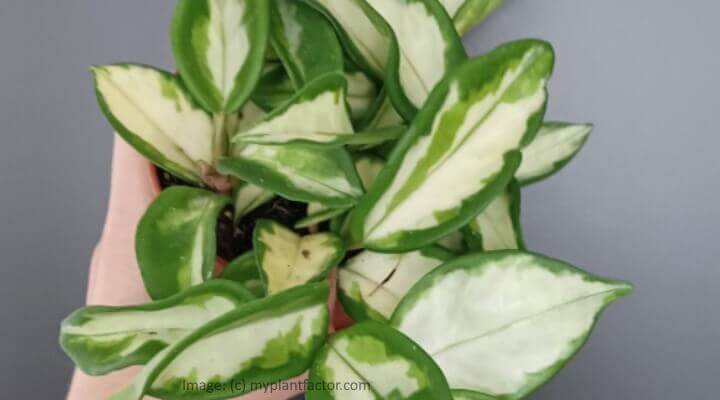
You may face the same challenge as this hoya newbie. They told me: “I struggled to tell my Carnosa apart from my Pubicalyx at first—the splashes of silver looked so similar. Eventually, I learned that Carnosa leaves are thicker and less pointed, which helped clear things up.”
Related reading: How to propagate a hoya carnosa houseplant.
How to identify Hoya Carnosa ‘Compacta’ leaves
Known for its tightly curled leaves that twist along the vine, Hoya Compacta is a favorite for hanging baskets. Its unique growth habit makes it a conversation piece, and its waxy, twisted foliage can even develop splashes of variegation.
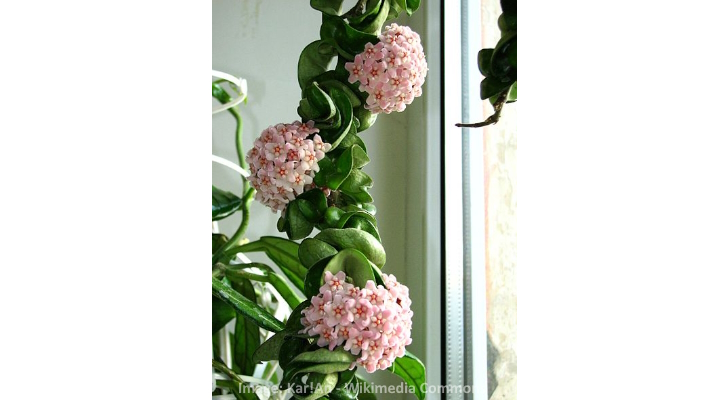
You might have the same realization as this new collector. They shared: “I thought my Compacta was shriveling up or sick because the leaves were so twisted. I had no idea that’s just how it grows—tightly coiled and completely unique. Now, it’s the star of my collection.”
Hoya Vitchii Leaf Identification
Notice a narrow, slightly pointed leaf with bold midrib veining and a coppery sheen when stressed? You’re likely looking at a Hoya Fitchii. It’s one of the more dramatic leaf forms and a favorite among collectors for that rich, veined texture that glows under bright light.
“Mine blushes this incredible rusty red under high light—Fitchii is honestly my favorite foliage hoya right now.” — Reddit user
Hoya Linearis leaf identification
For those who love elegance, Hoya Linearis is the ultimate choice. Its long, needle-like leaves cascade in soft, trailing vines, making it perfect for high shelves or hanging displays. The velvety texture of its foliage adds an unexpected charm.
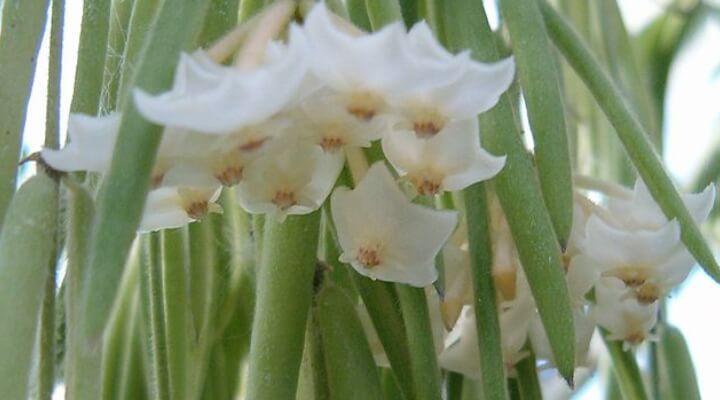
Reader insight: “I almost mistook my Linearis for a random trailing succulent at the garden center. It’s so different from other Hoyas that I second-guessed myself until it started flowering.”
Identifying Hoya Pubicalyx by its leaves
For anyone drawn to bold, dramatic foliage, Hoya Pubicalyx is a standout. Its lance-shaped leaves, often adorned with splashes of silver or purple, make it one of the most eye-catching Hoyas in any collection. Add in its fast-growing vines and tolerance for less-than-perfect care, and it’s no wonder Pubicalyx is a favorite among beginners and seasoned collectors. Popular cultivars like ‘Red Button,’ ‘Silver Pink,’ and ‘Royal Hawaiian’ add to its allure—but that’s where things can get tricky.
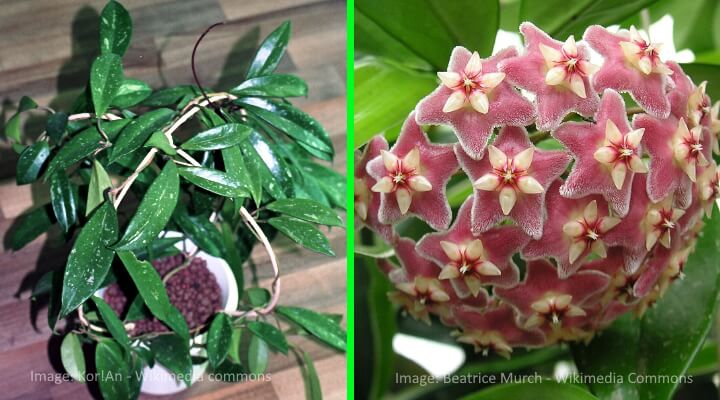
I remember what one friend told me when they started collecting hoyas. She said: “I spent months figuring out whether my plant was a Pubicalyx or a Carnosa because the splash patterns can look so similar. It wasn’t until the leaves grew longer and more pointed that I finally knew.”
Easiest Hoya to identify leaf shape: Hoya Kerrii
Few plants are as instantly recognizable as Hoya Kerrii. Its heart-shaped leaves make it a favorite for gifting, but this species is more than just cute—it’s also hardy and low-maintenance. It’s often sold as a single-leaf cutting, making identification easy as no other hoyas are sold this way.

You may find yourself in the same situation as this curious grower. They explained: “I bought a Kerrii because of the heart-shaped leaf, but it didn’t grow for months. It turns out it was just a single-leaf cutting with no vine attached. A quick check would’ve saved me the disappointment.”
Want to find out the best way to care for this unique hoya variety? Check out my guide on how to identify and care for Hoya Heart plants.
How to identify a Hoya without flowers: Hoya Retusa
If minimalism is your style, Hoya Retusa might just be the plant for you. This species stands apart from its Hoya cousins with its narrow, grass-like leaves that are unlike the thick, waxy foliage Hoyas are known for. Its unique appearance makes it a conversation starter, but identifying Hoya Retusa can be tricky, especially if you’re unfamiliar with its quirks.
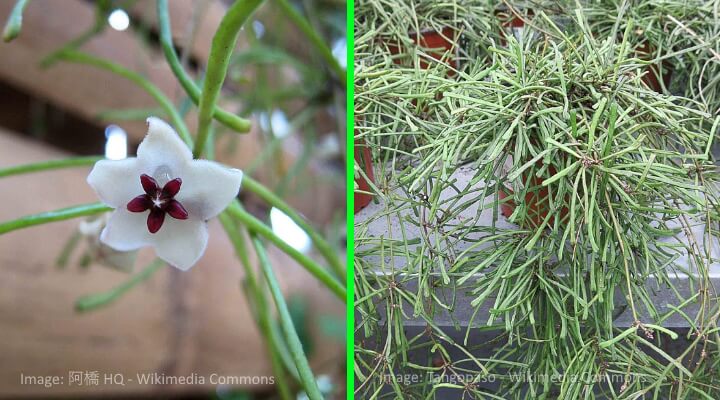
You may face the same challenge as this Hoya newbie. They told me: “When I first brought home my Retusa, I thought I’d picked up the wrong plant. It looked nothing like the lush Hoyas I was used to. But once it started trailing and blooming, I realized just how unique it is.”
Related reading: How can I get my hoya plant to bloom?
Top Tips on Mastering Hoya Leaf Identification
Mastering Hoya leaf identification can feel overwhelming at first, but trust me—it’s all about breaking it down into manageable steps. Over time, you’ll start spotting the subtle differences that make each species unique. Here’s what I’ve learned from years of trial, error, and plenty of “aha” moments. These tips will help you confidently identify your Hoya, no matter how tricky it seems.
Observe the Basics: Shape, Size, and Texture
Start with the essentials. Is the leaf heart-shaped, long and slender, or compact and curled? Check the texture next. Most Hoyas have smooth, waxy leaves, but some, like Hoya Fungii, are velvety. Take note of size too—larger leaves often indicate species like Hoya Macrophylla, while smaller ones might point to Hoya Retusa.
You may face the same challenge as this Hoya owner. They told me: “I was sure my plant was a Kerrii because of its heart shape, but the vine gave it away as Pubicalyx. I learned to never rely on one feature alone.”
Pay Attention to Growth Patterns
Take a step back and observe how the plant grows. Does it trail elegantly, like Hoya Linearis, or form tight clusters, like Hoya Compacta? The way leaves are arranged along the stem is another clue. Paired leaves are typical in species like Hoya Pubicalyx, while others, like Hoya Retusa, grow in a scattered fashion.
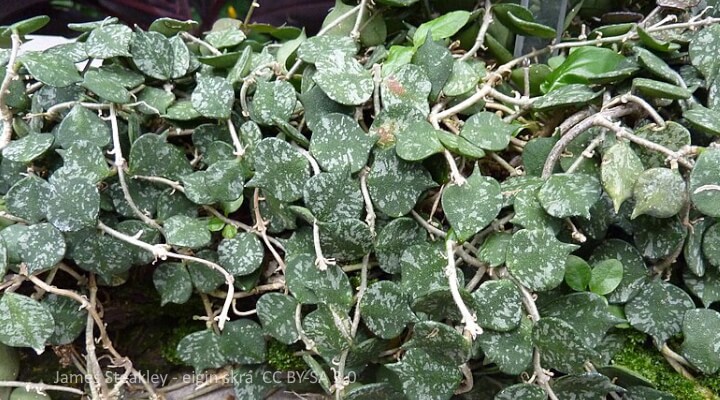
Use Lighting to Your Advantage
Lighting can completely transform how a Hoya looks. Bright, indirect light often enhances variegation, making silver splashes or creamy edges pop. On the other hand, dim lighting can dull colors and hide details.
A fellow enthusiast shared: “I thought I had a plain Carnosa until I moved it to brighter light. Suddenly, the patches of yellow and pink appeared, and I realized it was a Krimson Princess!”
Document What You See
Take photos of your Hoya’s leaves from different angles and in good lighting. Over time, these images can be compared to online guides or community feedback. Documenting your plant can help track changes and give you valuable reference points for identification.
Look for Distinct Features
Every Hoya has something that sets it apart. For example:
- Hoya Macrophylla: Bold veins on large leaves.
- Hoya Kerrii: Iconic heart-shaped leaves.
- Hoya Pubicalyx: Lance-shaped leaves with silvery splashes. Spotting these standout traits will quickly narrow down the possibilities.
One collector confided: “I couldn’t figure out my Hoya until someone pointed out the veining on the leaves. That one detail made all the difference.”
Join the Community
Don’t go it alone. Hoya enthusiasts are some of the most passionate plant people you’ll meet. Share photos of your plant in online forums or groups, and you’ll often get feedback from seasoned collectors. Plus, it’s a great way to learn tips you won’t find in guides.
Be Patient
Hoyas can take time to reveal their true characteristics. Sometimes, a plant’s appearance changes as it matures or adjusts to its environment. When in doubt, give it time and revisit your observations. I remember what a first-time hoya parent told me, “I almost gave up on identifying my Pubicalyx because it looked so plain at first. A year later, the splashes started showing, and it all clicked.
I’ve realized that Hoya leaf identification isn’t about perfection but observation, patience, and curiosity. By focusing on small details and staying open to learning, you’ll unlock the secrets of your Hoya collection one leaf at a time. And when that moment of recognition comes, it’s worth every effort.
Overcoming Common Challenges When Identifying Hoya Leaves
Identifying Hoya leaves isn’t always straightforward. One day, you’re convinced you’ve got a Hoya Carnosa, and the next, those silver splashes make you second-guess everything. The subtle differences between species, the impact of lighting, and even the tricks hybrids play can turn what should be a fun puzzle into a frustrating guessing game. But don’t worry—these challenges are common, and with a bit of insight, they’re easy to overcome.
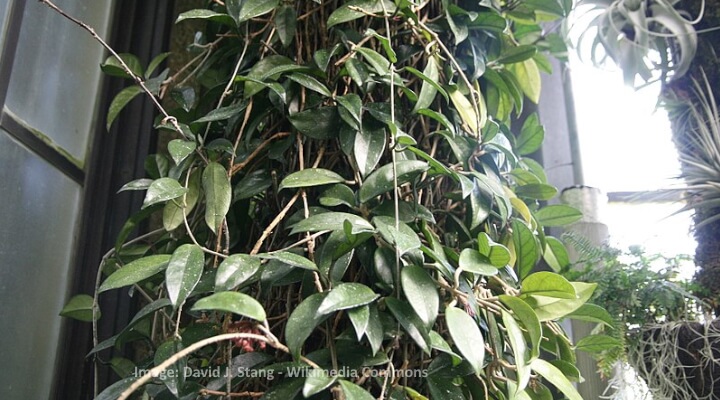
Here’s a breakdown of the most common problems and how to solve them:
- Similar-looking species confuse you: Focus on the details. Compare traits like leaf shape (rounded vs. lance-shaped), texture (waxy vs. velvety), and variegation patterns. For instance, Hoya Carnosa leaves are thicker and more rounded than the pointed, splashy leaves of Hoya Pubicalyx. Don’t rely on one feature—combine observations.
- Variegation looks inconsistent or fades over time: Check your lighting. Variegated Hoyas like Krimson Princess thrive in bright, indirect light, where their creamy or pink tones pop. In low light, those colors fade, making identification trickier. Move your plant to a brighter spot and watch the variegation reappear.
- Yellowing, drooping leaves blur critical traits: Dial in your watering. Hoyas hate sitting in soggy soil, and overwatering is a quick path to yellow, limp leaves. Let the soil dry out between waterings and switch to a chunky, well-draining mix to keep roots healthy and leaves vibrant.
- Growth habits don’t match expectations: Know your Hoya’s natural tendencies. Hoya Compacta grows in tight curls, while Hoya Linearis trails delicately. If your plant looks “messy” or sparse, it could be adjusting to new conditions or showing its natural habit. Step back and observe its overall growth pattern.
- Hybrids blur the lines between species: Look for defining traits rather than relying on general assumptions. For example, hybrids of Hoya Pubicalyx might mimic Hoya Carnosa but tend to have thinner, more pointed leaves. Ask experienced collectors or consult community groups if you’re stuck.
- Pests or environmental stress alter the leaf appearance: Inspect your plant for signs of stress, like discoloration, curling, or spots. Thrips and mealybugs can distort leaves, making ID harder. Treat issues promptly and wait for the plant’s recovery before revisiting identification.
- Your Hoya isn’t flowering: Flowers can be a definitive ID clue, but many Hoyas take years to bloom. Don’t let that stop you—focus on leaf traits in the meantime and nurture your plant with consistent care. Patience pays off when those blooms finally appear.
- Leaves lose their waxy, glossy look: Boost the humidity. Hoyas love moisture in the air, and when the air is too dry, their leaves become dull. Use a pebble tray, mist lightly, or add a humidifier to your space to help them hold onto their signature shine.
- Small, deformed leaves replace the typical growth pattern: Feed the plant. A malnourished Hoya can’t show its best traits. Use a balanced liquid fertilizer every 4–6 weeks during the growing season to encourage full, healthy leaf development.
You’ll turn those frustrations into breakthroughs by sharpening your eye for detail, optimizing your plant’s conditions, and staying connected with the Hoya community. Keep going—it’s worth it.
Maintaining Healthy Leaves for Better Identification
Healthy leaves are the foundation of accurate Hoya identification. When your plant is thriving, its true traits—like shape, texture, and variegation—shine through, making it much easier to recognize.
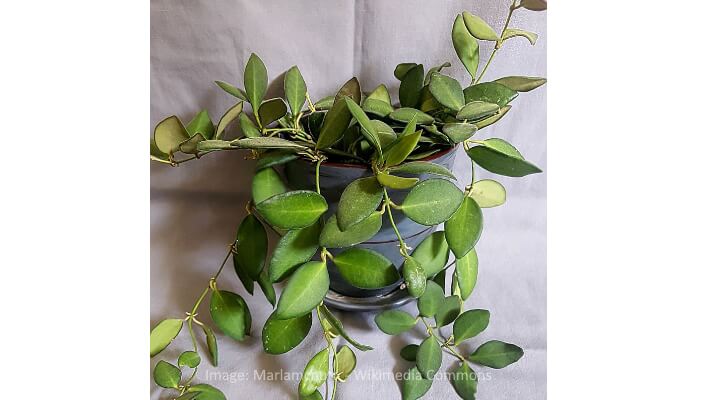
Here’s how you can proactively care for your Hoya to ensure its leaves stay in top condition while naturally avoiding common pitfalls:
- Water Consistently: Let the soil dry out between waterings to prevent overwatering, which causes yellowing or drooping leaves. A chunky, well-draining mix keeps roots happy and foliage vibrant.
- Provide Bright, Indirect Light: Variegated Hoyas need plenty of indirect sunlight to maintain their striking patterns. Inadequate light dulls colors and makes variegation fade, but the proper lighting keeps those creamy or pink tones vivid.
- Boost Humidity: Use a pebble tray, humidifier, or misting to create the moisture levels Hoyas love. Dry air can make leaves lose their signature glossy sheen, but healthy humidity keeps them lush and shiny.
- Feed Regularly: Use a balanced liquid fertilizer every 4–6 weeks during the growing season to encourage strong, full leaf growth. Proper nutrients prevent stunted or deformed leaves, ensuring your Hoya looks its best.
- Keep Conditions Stable: Place your Hoya in an environment with consistent lighting, temperature, and watering routines. Erratic changes stress the plant, which can distort its leaves or mask its true characteristics.
Taking these steps helps your Hoya thrive and ensures that its leaves reflect its unique identity. A healthy plant is easier to identify—and far more rewarding to care for.
My top hoya tip: Don’t rush to identify a stressed plant—it’s a losing battle. Focus on getting it back to full health first. Identification becomes straightforward when the leaves are strong, glossy, and vibrant. Healthy plants don’t just look better—they tell their story.
Engage with the Hoya Community
Engaging with the Hoya community is one of the fastest ways to grow your plant knowledge and connect with other enthusiasts. Share photos of your Hoyas in online groups or forums like Reddit’s r/Hoyas or Facebook’s Hoya-specific communities, and ask for feedback on tricky identifications.
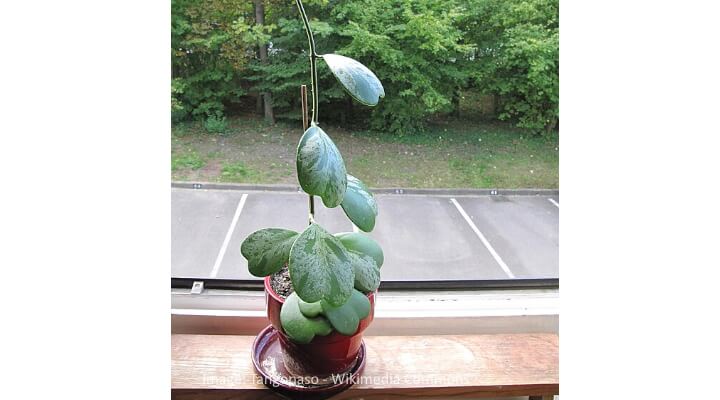
You’ll often find seasoned collectors eager to share tips, troubleshoot issues, or help you spot defining traits. Joining discussions not only sharpens your skills but also gives you access to a wealth of real-world advice from people who’ve tackled the same challenges. The best part? You’re never alone in your plant journey.
Quick FAQ for Hoya Leaf Identification
Why is my Hoya’s leaf color fading?
Your Hoya likely needs more light. Variegation and vibrant colors fade in low light. Move it to bright, indirect light, and the colors should return.Can I identify my Hoya without flowers?
Some hoyas rarely bloom; therefore, identifying them by their leaves is the best way. Focus on leaf traits like shape, texture, size, and variegation. Growth habits and leaf arrangement are also vital clues.Which Hoyas are easiest for beginners?
The best hoya plants for newbies are Hoya Carnosa and Hoya Gracilis—the ultimate beginner-friendly wax plants. They’re hardy, forgiving, and thrive with minimal care.How do I distinguish a hybrid Hoya?
Hybrids often combine traits from parent plants, so look for subtle differences in leaf size, shape, or variegation. Community feedback can also help.What tools can help with Hoya leaf identification?
A magnifying glass for details, a camera for clear photos, and apps like PlantSnap or Seek can provide quick insights.Do Hoya plants have fuzzy leaves?
It’s good to remember that some hoya species naturally have fuzzy leaves—so there’s nothing to worry about here! Hoya Fungii and Hoya Tomentosa have soft, velvety leaves, while most other hoyas are smooth and waxy.How do I identify my hoya plant by its leaves?
Look at leaf shape, size, thickness, texture, and markings. Heart-shaped leaves often indicate Hoya Kerrii, while narrow or curly leaves may point to Hoya Retusa or Hoya Linearis. Splashy markings are common in Hoya Pubicalyx, while veined or quilted leaves may suggest Hoya Callistophylla.What do splashy hoya leaves mean?
Splash refers to silvery speckles or patterns on the leaf surface. It’s often genetic but can also be affected by light. Popular splashy hoyas include Hoya Pubicalyx, Krimson Princess, and Hoya Macrophylla.Can I tell the hoya species without flowers?
Yes—many hoya varieties can be ID’d by their leaves alone. Focus on leaf texture, shape, size, and vein structure. Blooms help, but leaves give daily clues.What’s the difference between veiny and splashy hoyas?
Veiny hoyas show raised or colored vein patterns (like Hoya Callistophylla). Splashy ones have silver speckles (like Pubicalyx). Some rare varieties have both.Is my Hoya Kerrii real or just a single leaf?
Check for a node. True Hoya Kerrii vines grow from a stem with nodes. Single-leaf cuttings (sold as “Valentine Hoya”) rarely grow into full plants.Are hoya leaves supposed to be thick and waxy?
Most are! Hoyas are semi-succulents, and their leaves often feel rubbery or firm. But not all—Hoya Linearis and Hoya Retusa have delicate, thin leaves instead.My Thoughts on the Challenges of Identifying Hoya Leaves
Identifying Hoya leaves can feel like solving a puzzle with too many pieces—and I’ve been there. The subtle differences between species, how light transforms variegation, and the occasional hybrid surprise can leave even seasoned collectors scratching their heads. But that’s part of the magic, isn’t it? Each leaf tells a story, and the more you observe, the more you connect with your plants.
What I’ve learned is that patience and curiosity go a long way. Healthy plants reveal their true traits over time, and engaging with the Hoya community always brings fresh perspectives. Sure, it’s a challenge, but it’s rewarding and deepens your appreciation for these incredible plants. And honestly? Every time you finally nail an ID, it feels like a little victory. That’s what makes it all worth it.
